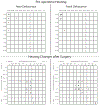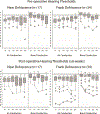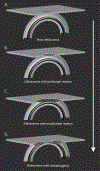Clinical and Physiologic Predictors and Postoperative Outcomes of Near Dehiscence Syndrome
- PMID: 30570606
- PMCID: PMC6326856
- DOI: 10.1097/MAO.0000000000002077
Clinical and Physiologic Predictors and Postoperative Outcomes of Near Dehiscence Syndrome
Abstract
Objective: To identify predictors of near dehiscence (ND) or thin rather than dehiscent bone overlying the superior semicircular canal in patients with signs and symptoms suggestive of superior semicircular canal dehiscence syndrome (SCDS), as well as postoperative outcomes.
Study design: Retrospective case-control study.
Setting: Tertiary referral center.
Patients: All 288 patients who underwent middle cranial fossa approach for repair of SCDS (1998-2018) were reviewed for cases of ND. Demographics, symptoms, and clinical signs including nystagmus, ocular vestibular-evoked myogenic potential (oVEMP) amplitude, cervical vestibular-evoked myogenic potential (cVEMP) thresholds, and low-frequency air-bone gap were compared before and after surgery.
Main outcome measure: Presence of preoperative ND and postoperative symptoms and physiologic measures.
Results: Seventeen cases of ND (16 patients, 17 ears) and 34 cases (34 ears) of frank SCDS were identified. ND cases differed from frank dehiscence cases in that they were less likely to have nystagmus in response to ear canal pressure or loud sounds, OR = 0.05 (95% CI 0.01-0.25) and Valsalva, OR = 0.08 (0.01-0.67), smaller peak-to-peak oVEMP amplitudes, OR = 0.84 (0.75-0.95), and higher cVEMP thresholds, OR = 1.21 (1.07-1.37). Patients with ND had similar symptoms to those with frank SCDS before surgery, and after surgery had outcomes similar to patients with frank SCDS.
Conclusions: In patients with symptoms consistent with SCDS, predictors of ND include absence of nystagmus in response to pressure/loud sounds, greater cVEMP thresholds, and smaller oVEMP amplitudes. We propose ND is on a spectrum of dehiscence that partially accounts for the diversity of clinical presentations of patients with SCDS.
Conflict of interest statement
Figures



References
-
- Carey JP, Minor LB, Nager GT. Dehiscence or thinning of bone overlying the superior semicircular canal in a temporal bone survey. Arch Otolaryngol Head Neck Surg 2000; 126:137–147. - PubMed
-
- Welgampola MS, Myrie OA, Minor LB, Carey JP. Vestibular-evoked myogenic potential thresholds normalize on plugging superior canal dehiscence. Neurology 2008; 70:464–472. - PubMed
-
- Minor LB. Clinical manifestations of superior semicircular canal dehiscence. Laryngoscope 2005; 115:1717–1727. - PubMed
-
- Minor LB, Solomon D, Zinreich JS, Zee DS. Sound- and/or pressure-induced vertigo due to bone dehiscence of the superior semicircular canal. Arch Otolaryngol Head Neck Surg 1998; 124:249–258. - PubMed
MeSH terms
Grants and funding
LinkOut - more resources
Full Text Sources
Miscellaneous

